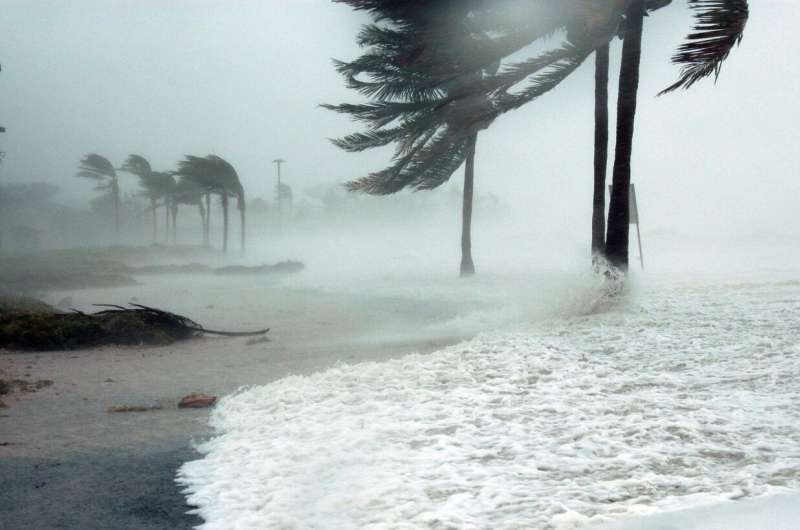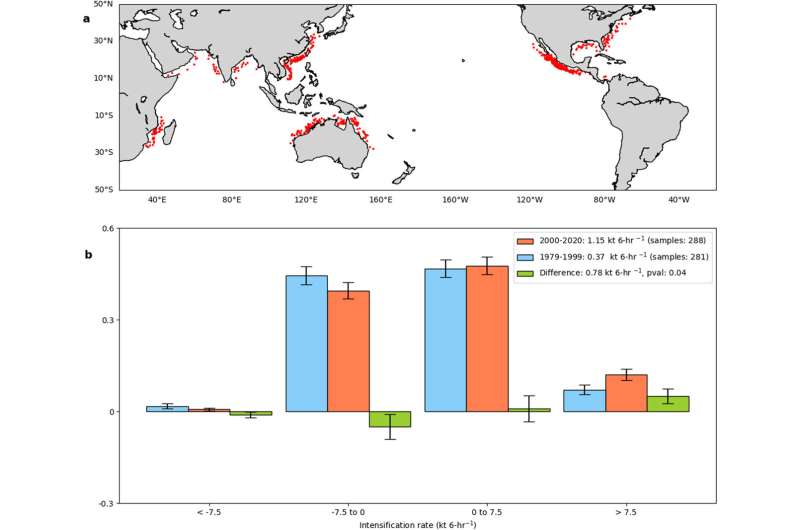This article has been reviewed according to Science X's editorial process and policies. Editors have highlighted the following attributes while ensuring the content's credibility:
fact-checked
peer-reviewed publication
trusted source
proofread
Coastal hurricanes around the world are intensifying faster, new study finds

Hurricanes are among the world's most destructive natural hazards. Their ability to cause damage is shaped by their environment; conditions like warm ocean waters, guiding winds, and atmospheric moisture can all dictate storm strength.
A new study led by scientists at the Department of Energy's Pacific Northwest National Laboratory finds that coastal conditions have changed since 1979, driving nearshore hurricanes around the world to intensify at a quickening pace. What's more, new projections suggest this rate will continue climbing should current warming trends continue. The paper is published in the journal Earth's Future.
Much work has been done to document how hurricanes are changing in our warmer world. Past research has shown these storms may grow wetter, threatening heightened risks of flooding. Other work suggests they may strike more often in some areas and that their intensity may peak closer to the coast, posing additional risk to the roughly 40 percent of the world's population that lives within 100 kilometers (62.13 miles) of a coastline, according to the United Nations.
Yet, until now, no one has documented whether coastal hurricanes are intensifying faster at a global scale. Looking at past data, the authors of the new work found that the average rate at which these storms intensified over the period from 1979 to 2000 was 0.37 knots every six hours. That pace picked up for the period from 2000 to 2020, where the mean intensification rate was 1.15 knots every six hours.
In the two decades preceding the year 2000, on average, a hurricane might have begun at a certain intensity and increased in strength by roughly 1.5 knots over the course of a day. After 2000, an average hurricane could begin at the same intensity and strengthen by about 4.5 knots during the same 24-hour period.
Also new is the finding that this global trend is likely to ramp up under climate change. Much hurricane research focuses on historical observations, looking at past records to investigate potential trends in hurricane intensification.
In the new work, climate modeling revealed how hurricanes could shape up in the coming decades. On nearly every coastline of the world's continental landmasses, hurricanes are likely to intensify faster as the world warms, according to the new work.
"We're not talking about intensification out in the middle of the ocean," said lead author and climate scientist Karthik Balaguru. "We're talking about it happening right at the coastline, where it matters most." Though the change is unique to the coastal environment, islands could face the same risk, Balaguru added, because the same rise in intensification may develop near the Philippines and Madagascar.
Rising intensification rates: what's behind the change?
The authors of the new work point to increased humidity and weakened wind shear as major contributors to the climbing rate of intensification, with the latter playing a particularly important role in the future.
Wind shear refers to changes in wind speed and direction in different altitudes of Earth's atmosphere. Imagine traveling straight up from the planet's surface as if you were in an elevator. Winds would not be uniform as you move through atmospheric layers—you might encounter powerful gusts in one layer and perhaps weaker winds moving in a different direction a few kilometers above.
Vertical wind shear holds great influence over a hurricane's strength. If sufficiently strong, wind shear can rob moisture from the storm's core, sapping its power. Too weak, and that's one less check on intensifying hurricanes.
Balaguru's team found that wind shear is likely to weaken across much of the globe, especially near the Northern Hemisphere coastal regions, in a warmer climate. There are likely multiple factors at play.
Heat transferred from the subtropical ocean surface to the air above alters atmospheric circulation patterns, ultimately leading to weaker wind shear across U.S. coastlines. Over Northeast Asia, warming in the upper levels of Earth's atmosphere is the primary driver behind weaker wind shear there. Past research has shown that the higher levels of Earth's atmosphere are warming faster than the planetary surface.
"This work holds profound implications for people living on the coast, as well as operational forecasters and decision-makers," said co-author and Earth scientist Ruby Leung. "The rising intensification rates we observed could mean that landfalling hurricanes are on track to grow stronger and thus more destructive. It's important that we understand how the risks posed by these storms could change as our climate changes."
The authors point out that rising intensification rates are not completely uniform across the globe. Along the west coast of Mexico, for instance, the data do not indicate that hurricanes are intensifying significantly faster.
In line with flagging the many ways global warming could influence extreme weather this century, Balaguru recently led another team to uncover a surprising link between hurricanes and another form of natural hazard: wildfires.

Cyclones and wildfire
In work published earlier this year, Balaguru and his co-authors found that hurricanes originating in the Eastern Pacific ocean could influence wildfire weather in the Southwest United States.
Eastern Pacific hurricanes tend not to make landfall often. Their paths typically remain in ocean waters. From September to October, however, the storms are more likely to defy that trend.
Hurricane Hilary, for example, formed in the Eastern Pacific and soon touched down on the western Baja California Peninsula, leading the National Hurricane Center to issue its first-ever tropical storm warning for Southern California.
Balaguru's team found that Eastern Pacific hurricanes could dampen wildfire risk in the Southwest U.S. by delivering precipitation and boosting the amount of moisture in both the soil and atmosphere. Indeed, the researchers observed less wildfire-burned land in periods after the storms made landfall.
The team's climate model projections suggested this hurricane activity may dial down in the Eastern Pacific in the decades to come, due also to global warming. Without their delivery of moisture into the already fire-prone region, it's possible wildfires could spark up more often.
However, more work is needed to understand the complete relationship between the two phenomena. Moisture brought by Eastern Pacific hurricanes could also fuel vegetation growth in the Southwest U.S., for example, adding fuel for future fires.
More information: Karthik Balaguru et al, A Global Increase in Nearshore Tropical Cyclone Intensification, Earth's Future (2024). DOI: 10.1029/2023EF004230
Journal information: Earth's Future
Provided by Pacific Northwest National Laboratory




















